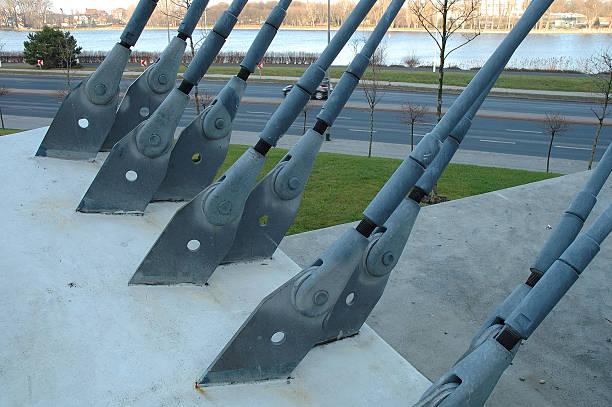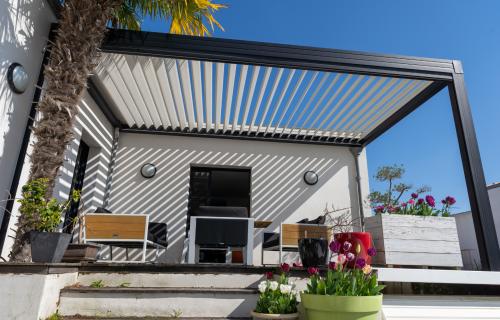Different Types of Gutters for Your Roof

Have you ever seen those rain gutters along the edge of roofs and wondered what they're for? A gutter can be defined as a trough or channel on the roof of a building, usually for carrying off rainwater. It's an important part of your roofing system and, if installed improperly or not maintained regularly, can lead to some serious problems for your home. That's why it's important to choose the right gutter for your roof.
There are a few different things to take into account when choosing the right gutter for your roof. Firstly, you need to consider the pitch of your roof; this is how steep it is. The most popular type of gutter for a pitched roof is the half-round gutter, as it can be fitted easily and suits most roofs. If you have a flat roof, then you will need to choose a box gutter. These come in different shapes and sizes, so you will need to find one that complements your property. Finally, you need to think about maintenance. Some gutters require more upkeep than others. Choose wisely, and you'll have years of protection from water damage!
Gutters are a crucial element in maintaining the condition of your roof. In this article, we will take a closer look at every type of gutter available on the market today, their specifications, the materials they are made of, and how you can choose from them depending on your roof type, gutter restoration, and renovation or construction plans. We will also provide tips on how to choose the right gutter for your needs.
Types of Gutters
The durability and longevity of your home’s exterior are dependent on the quality of the gutter system you have in place. From rain gutters themselves, which can be made from metal or plastic, to their installers, who must also follow safety protocols when working with these systems, nothing should be left out! Here are the different types of gutters and materials available.
K-Style Rain Gutters
As the name suggests, K-style gutters resemble the letter K when viewed sideways. This is the most prevalent type of home built in the last 50 years, and many older homeowners still use it today. The front edge of this gutter has a unique form that resembles crown moulding on modern homes. As a result, these gutters will complement the appearance of your home. In fact, many homeowners may select a K-style gutter colour that complements or contrasts with their home's trim and/or shutters. Because the K-style gutter has a flat back, it can be nailed directly to the fascia board without the use of brackets. Water cannot run down your wall because it is flush against the wall. Because of the bends and folds in the metal, these gutters are more resistant to damage than half-round gutters.
The advantage of these K-style gutters is that they can normally carry more water than other gutter styles due to their flat bottoms and straight, outwardly angled sides, making them ideal for wet conditions. The inner angles gather rotting debris, making K-design gutters a little more difficult to clean than other styles. The two most popular sizes available on the market are 5′′ and 6′′, with the 5′′ being the industry standard and the 6′′ being for somewhat more water volume.
Half-Round Gutters
Historic or older types of residences are more likely to have this type of gutter. They are half of a circular pipe with the top half open for water, and their names appropriately describe them. They're noted for being more rustic due to the fact that they're usually constructed of copper, which develops a patina over time. Because of their open, trough-like appearance, they are prone to being clogged with leaves and debris, which is why many homeowners choose to install leaf guards. Furthermore, because of their curved sides, they do not sit flush against the fascia boards, so brackets are usually required to keep them in place.
The installation of these gutters differs from that of standard gutters. First, along the roof edge, brackets are attached to the house. The half-round gutter is then slid into place and secured after the brackets are in place. Copper gutters are far heavier than aluminium gutters, necessitating the use of additional hardware to secure them to the house. As we stated earlier, it is usually made of copper, but aluminium, vinyl, or galvanised steel are also available, and just like the K-style, these are available in 5′′ and 6′′ sizes.
Box Style Gutters
These are extra-large gutters that are typically found on commercial or industrial structures. They're designed to manage a lot of water from roofs that are higher up. The larger your roof, the more water it can produce. Traditional gutters hang on the edge of the roof, whereas box gutters do not. They have a tall back part that tucks under the roof shingles. As a result, they must be installed during the construction of the building. This prevents water from entering the building along the roof edge. You can put these on an older building, but you'll still need to replace the shingles on the roof. Box gutters come in basic sizes of 7′′ and 8′′, but higher sizes, such as 10′′, are available.
Custom-Built Fascia Gutters
Custom-built fascia gutters, unlike the other three styles, aren't offered in sections that fit together, leaving exposed seams prone to rust and leaks. Instead, fascia gutters are made to order from a single continuous stretch of aluminium. Fascia gutters are expensive and require expert installation; they can cost up to twice as much as half-round or K-style gutters that you can install yourself. Depending on the size of your home, this can add up to hundreds or a couple hundred dollars.
Types of Materials
Aluminium: This is the most common rain gutter material, whether seamed or seamless. There are three typical thicknesses for aluminium gutters: .025 inch, .027 inch, and .032 inch. While the cheapest aluminium is the thinnest, it is also the most likely to dent or bend; thicker metal is slightly more expensive but often worth it, especially if you live in a snowy climate. Here are some advantages of using this type of material: it won’t rust; it is lightweight and easy to install; it is available in many colours, and can also be painted; it is weatherproof, and can last up to 25 years.
Galvanised Steel: This is more durable than aluminium gutters, especially in harsh conditions. Although most steel rain gutters are galvanised to help them resist rust, oxidation will still occur after 10 to 15 years. While leaf guards can help extend the life of any rain gutter, they're especially crucial for galvanised steel gutters, as soggy masses of falling leaves hasten to rust. Stainless steel gutters will not rust, but they are more expensive than galvanised steel gutters.
Copper: Copper has a distinct beauty, but the gleam will fade over time. Weather-worn copper, according to many homeowners, adds to its antique look. Copper is the most expensive type of rain gutter, and it isn't appropriate for DIY installation. Copper is incredibly resilient, unaffected by any weather condition, from the hottest heat to the coldest freezing. Copper rain gutters, which are typically found in high-end homes, can survive for up to 100 years if installed and welded properly.
Zinc: This type of material is costly, but it is extremely long-lasting, defying corrosion, weathering, and warping. Zinc gutters can last up to 50 years if properly maintained (somewhat less if you live near the ocean or anywhere else with salty air). Zinc gutters will develop an appealing patina over time, despite starting out as a dreary gray. These are only used on historic or high-end homes and require professional installation because the joints and ends must be welded.
Vinyl: Because it's lightweight, easy to cut, and snaps together, vinyl is the cheapest and easiest option for DIY installation. Vinyl gutters come in a variety of colours and can be custom painted to match your home's decor. Vinyl gutters are the least long-lasting gutter material; in mild regions, they can last up to 20 years. In direct sunshine, it's also prone to fading.
Considering the Right Gutter for you
When it comes to new gutters or gutter restoration, there are several factors to consider, such as shape, material, and price. But don't forget about performance and quality, which will save you time and money in the long run by requiring less care and providing long-lasting beauty. Gutters are an important part of a home's drainage system, and they, like many other external features, wear and tear over time. Examining and cleaning the gutters should be a top priority on your spring maintenance agenda. Cleaning and maintaining your gutters on a regular basis will help ensure that they last as long as possible.
If your gutters are exhibiting symptoms of significant wear—for example, cracks, holes, and leaks—or if they're sagging or pushing away from the house, or if there are several missing, loose, or bent fasteners, it's time to replace them. Water damage to the roof, fascia board, decking, or rafters, according to experts, is a solid sign that gutters need to be replaced. Some of the roof restoration companies today offer gutter restoration services including gutter cleaning, replacement, painting, and many more.
There are a variety of gutters available for your roof, and each has its own benefits and drawbacks. This article looked at the different types of gutters and discussed the pros and cons of each. If you are in the market for gutters for your roof, be sure to check out this article and leave a comment with your thoughts.










Comments